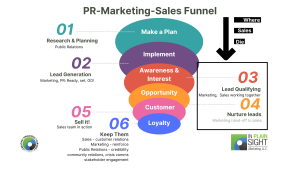Maybe You Need an Alignment
by Kathie Taylor, APR, CAPM
Do your sales suck? Sales, marketing, and public relations (PR) are often used interchangeably in business. People like to think marketing makes the sales, or you don’t need marketing to make the sales. Without properly aligning them all, your sales will suck. It’s a conundrum, isn’t it? And what the hell is PR anyway?
At IPSM, we recently decided to only work with B2B and B2C companies that have a robust sales process in place or are willing to work with us to build one. Our marketing and PR efforts are research-based and strategic. Without a sales process that aligns with our efforts, those leads won’t turn into revenue, and our clients won’t see the success they’re striving for.
We believe so strongly in the relationship between PR, marketing, and sales that we have sat with dispatch and customer service departments to observe their process, worked side by side with sales teams, and gone on ride-alongs with clients to ensure the company could and would deliver on the brand promise our marketing and PR puts out there.
Waaaaaaay back in my career, I worked retail, selling fine jewelry. I loved the romance of the business, but hated the way the owner of the company would launch himself out of his office every time a customer left empty handed, screeching at the top of his lungs, “Follow up, follow up, FOLLOW UP!”
But you know what? He’s not wrong. The best marketing in the world will only work if you follow up on the leads generated by your marketing team.
If your sales team can’t, don’t, or won’t follow up, all the marketing and public relations in the world will not save your business’ reputation. Or revenue.
Let’s get real here – what are each of these components, and how do they work?
Sales: The Direct Revenue Driver
Sales is the most straightforward concept for many businesses. At its core, sales directly generates revenue by converting leads and prospects into paying customers. This should be easy to understand, yet we see over and over business owners who can’t sell themselves, let alone their products and services. Selling means interacting with the people who want to buy your products. A salesperson identifies needs, offers solutions, negotiates terms, and closes the deal.
If you want to close the deal, you have to take the leads generated by marketing, and turn them into cold, hard cash. Even the best marketing and PR efforts can fall flat without a robust sales process.
Why else are you in business, if not to generate revenue?
In a nutshell, sales is:
- Lead conversion: Turning prospects into paying customers.
- Customer relationship management: Building and maintaining relationships to nurture long-term loyalty.
- Revenue generation: Directly responsible for bringing in revenue.
With a clear and structured sales process, many businesses find that their marketing and PR efforts yield better results. This is why you, as a business owner, need to invest in sales process development as much as you need to invest in marketing and PR. Don’t cheap on the goods, or you’ll go out of business.
It’s not marketing’s fault if you won’t, don’t, or can’t sell.
Marketing: Creating Demand and Generating Leads
Marketing creates demand, generates leads, and makes your audience aware of your products and services. Marketing uses various methods like digital advertising, content marketing, email campaigns, and SEO to attract potential customers and guide them to the point where your sales team needs to take over. Marketing’s goal is to create awareness and interest in your product or service and qualify leads so the sales team can focus on high-potential prospects.
In a nutshell, marketing is:
- Lead generation: Attracting potential customers to engage with the brand.
- Brand awareness: Ensuring that the target market knows and trusts the brand.
- Demand generation: Creating a need for the company’s product or service through campaigns and content.
What is Marketing Automation?
Marketing automation is basically software and technology that automates marketing stuff like email campaigns, social media posting, and lead nurturing workflows. This tool empowers marketing teams to focus on strategy and creativity while automating manual, time-consuming processes.
Marketing automation helps you scale your business. If you’re just starting out, some of this can be handled manually, but to truly grow your business, automation is the way to go. Again, don’t cheap out on this. It’s important.
Marketing automation is:
- Efficiency: Automates repetitive tasks like sending out follow-up emails, allowing teams to focus on strategic initiatives.
- Personalization: Uses analytics to determine the behaviors, interests and where they are in the buying journey to build content to deliver relevant information.
- Lead nurturing: Continues to engage leads who may need more time to be ready to buy, ensuring they stay in the sales funnel.
- Integration with sales: By providing data analytics on how your leads consume your content, your sales team will be able to target their sales efforts more efficiently.
Marketing automation isn’t a replacement for strategy or planning—it enhances the execution of well-thought-out strategies and plans.
When used with a robust sales process, marketing automation can help streamline the handoff between marketing and sales, ensuring that leads receive consistent messaging and are nurtured through the funnel until they are ready for direct sales engagement.
What the Hell is PR?
Public relations often gets grouped with marketing, but it plays a distinctly different role. PR builds relationships with your community, grows and protects your business’ reputation, enhances credibility, and fosters relationships with the media, the public, and other stakeholders.
At IPSM, public relations informs everything we do. We structure our campaigns on four basic PR principles:
- Research: Gathering data on customers, competitors, and market trends to inform strategy and define what success looks like for you and determine our key performance metrics that will tell us if it’s working.
- Planning: Super critical! Without a plan, your implementation of strategies and tactics is going to suck. Planning ensures you have everything in place – no gaps between marketing and sales.
- Implementation: this is the rollout of everything we have planned. This should be a well-oiled machine at this point – if you didn’t have a sales process before, you better have one now.
- Evaluation: This is where we measure all the things to make sure our hypothesis for your success is on target. We might have to tweak a little here and there, but overall, we should be hitting our marketing and PR targets so that your salespeople can close the deal.
But wait – there’s more
People buy from people they trust. Telling your story is the best way to engage people in your business. A good PR professional (preferably accredited by a national professional organization like the Public Relations Society of America) will know how to develop a solid public relations plan to get your story out in the world. At IPSM, we tell BIG stories for small and micro businesses.
But public relations is more than just pretty stories. We also help with:
- Media Relations: Working with local, regional or national media to publish stories that tell your unique and authentic story. The best stories don’t say, “Hey, we’re great!”, they tell how you have made someone’s life easier and better.
- Crisis management: It’s going to happen someday. You need to have a plan to manage any emergencies, negative press or public perception issues that come up.
- Reputation management: Making sure you have positive online reviews and a means to respond to negative ones, keeping your crisis communication plan updated in case of emergency, and finding ways to interact with your community.
- Stakeholder communication: Building cascading messages to reach all stakeholders, from customers to investors to internal stakeholders like employees and vendors, as well as the general public.
Alignment – It’s Not Just for Chiropractors or Tires
Now that you know the difference between these separate but equally important entities, here’s why you need them to be aligned. When these teams work together, they become a powerful force driving growth and success. If you’re a small or micro-business, this may be a team of one or two, so finding a solid PR and marketing partner who understands your business, your market and your community is essential.
But what does it all mean?
Sales, Public Relations and Marketing Alignment: Marketing needs to generate qualified leads ready for sales engagement. Meanwhile, sales teams must provide feedback to marketing on the quality of those leads so marketing can continually refine its targeting strategies.
Marketing generates leads and PR builds awareness, your sales process is the key to turning those efforts into actual, measurable revenue.
Another time in the way back machine, I was the Sales Operations Director for an international sales performance training company. My job was to analyze our own sales performance (sales) and develop a customer experience program (public relations). We had an underperforming product our salespeople swore nobody wanted. Between the surveys we sent to people who took our programs, the surveys we sent to anyone at a director level or above, and our own sales team, we learned that people really DID want that product.
Working with marketing to rebrand the product, we sold it like crazy, increasing our revenue by 50% on that product in the first six months.
Without public relations (research and planning), marketing (promoting the product), and sales (selling the newly branded product like gang-busters), that product would have languished, our salespeople wouldn’t see giant increases in their numbers (and commissions), and our customers wouldn’t get what they wanted. We would lose credibility in the market, and somebody else would pick up where we left off.
It’s Not Your Father’s Sales Funnel Anymore
Think of it like this:

Your sales go to die when there is no established hand-off between marketing and sales. (Click to see a bigger version you can actually read.)
For example, a business with solid marketing but a weak sales process will fail to convert leads into revenue. Similarly, a company with a great product but no PR efforts may need help to gain the necessary credibility to attract new customers.
Help is On the Way
Don’t panic if you own a small or micro business.
Your job as the owner is to make sure your marketing and public relations plans match your sales goals, and that you have a solid sales plan in place.
If you do nothing with the leads marketing delivers, you’re not going to sell much. A stong partner like IPSM can help manage – and even develop – these operations.
But here’s the kicker – you have to participate! You can’t just “hire someone” – you have to roll up your sleeves and get in there so that all of your bases get covered. Then, once we know everything we need to know to launch your marketing and public relations plan in solidarity with your sales plan, you can watch it run.
Unless of course, you’re the sales guy.
We’re here to help. If you’re struggling with sales and marketing/PR alignment, click here to make an appointment with our CEO, Renee Plain.
Need more evidence? Check out these articles:
Forbes: 14 Ways PR And Sales Teams Can Help Meet Each Other’s Goals
YokelLocal: What to Do When Marketing and Sales Are Not Aligned
Sugar CRM: 5 Problems Caused by Sales and Marketing Misalignment
Agility PR Solutions: The Role of PR in Sales
Korn Ferry: How to Make Marketing an Invaluable Function
Hubspot: How to Create Strong Sales and Marketing Alignment in 2024
Hubspot: 10 Tried-and-True Tips for Sales and Marketing Alignment

